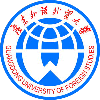Guangzhou City Facts & Districts
Guangzhou is located on the north of Pearl River Delta and
one of the biggest trading center in China. It is also one
of the most important centers of foreign commerce in South
China. The Chinese Export Commodities Fair or Canton Fair
has been held twice a year since 1957. The city is renowned
for its arts and crafts, namely Guangdong embroidery, ivory-carving
and ceramics.
Guangzhou is a famous hometown for overseas Chinese. It has
the largest population of overseas Chinese people. These overseas
Chinese do a great deal of good for Guangzhou: opening international
markets, bridging Guangzhou and the rest of the world, and
establishing many schools, hospitals, nurseries, kindergartens
and rest homes in Guangzhou.
Capital City Of |
Guangdong Province |
Population |
6,560,500 (Urban);
12,600,000 (Metro) |
Total Area Size |
434.4 square kilometers;
4.18 % of the whole province |
City Area Size |
3718.8 square kilometers |
Elevation |
8 meters (26 feet) |
Zip Code |
510000 |
Area Code |
020 |
Time Zone |
UTC (UTC+8) |
Electricity |
220 V |
Language |
Mandarin and Cantonese |
Ethnic Groups |
Han Chinese 91.9%; Zhuang,
Uygur, Hui, Yi, Tibetan, Miao, Manchu, Mongol, Buyi,
Korean, and other nationalities: 8.1% |
City Bird |
The Babbler (or the Chatterer) |
City Flower |
The Kapok |
City Emblem |
Statue of Rams |
Major Industries |
Light industry: garment
and textile, food processing, building material and household
electronic appliance; Heavy industry: automobile industry
, Equipment industry, automobile industry and petrochemicals
industry. |
Due to the rapid development of the provincial capital of Guangzhou in recent
years, a few counties and cities around have merged into Guangzhou Municipality.
Those newly set up districts are not only experiencing high-speed economic
growth, but also going through sweeping changes. The four former satellite
cities have joined hands to develop their tourist attractions to entertain
Guangzhou urbanites. It has become a big business.
The sub-provincial city of Guangzhou administers 12 county-level divisions,
including 10 districts and 2 county-level cities. The 10 districts / areas
include:
|
Yuexiu District
Liwan District
Haizhu District
Tianhe District
Baiyun District
|
Huangpu District
Huadu District
Panyu District
Nansha District
Luogang District
|
Yuexiu District
 As
one of the oldest urban areas in the city Yuexiu District is the birthplace
of Guangzhou, which enjoys a long history of more than 2,000 years. The district
is the political centre of Guangzhou as the provincial and municipal governments
are both situated inside. Guangzhou is prosperous in commerce. Yuexiu is
just the city' s traditional shopping centre. The well-known showcases include
Beijing Pedestrian Street, Nonglinxia Road, Yide-road Dried Seafood Market
and Toy Street, Liuhua Clothing Markets, Zhuangyuan-Fang lane of Stationery
and fun items, Yanjiang (Riverside) Bar Street, Gaodi Clothing Business Street
, Tiancheng-road Market of printing, Taikang-road and Danan-road Markets of
home decoration, Jiefang-road Market of Electronics, Huifu-road Food Street
etc. All these have been attracting sea of shoppers, tourists and investors. As
one of the oldest urban areas in the city Yuexiu District is the birthplace
of Guangzhou, which enjoys a long history of more than 2,000 years. The district
is the political centre of Guangzhou as the provincial and municipal governments
are both situated inside. Guangzhou is prosperous in commerce. Yuexiu is
just the city' s traditional shopping centre. The well-known showcases include
Beijing Pedestrian Street, Nonglinxia Road, Yide-road Dried Seafood Market
and Toy Street, Liuhua Clothing Markets, Zhuangyuan-Fang lane of Stationery
and fun items, Yanjiang (Riverside) Bar Street, Gaodi Clothing Business Street
, Tiancheng-road Market of printing, Taikang-road and Danan-road Markets of
home decoration, Jiefang-road Market of Electronics, Huifu-road Food Street
etc. All these have been attracting sea of shoppers, tourists and investors.
Yuexiu was ever the capital of three dynasties of ten emperors, and boasts
a large number of cultural relics and historic sites spanning a history of
2,210 years. Guangxiao Temple, Huaisheng Mosque, Nanyue Royal Tomb Museum,
Sun Yat-sen Memorial Hall and so on shines in this city heartland. The Chinese
Export Commodities Fair is held at the Liuhua Expo Center, Yuexiu District
twice a year and attracts hundreds of thousands of exhibiters and businessmen
from all over the world.
Liwan District
 Liwan
District is one of the old center districts of Guangzhou. The new Liwan District
has an area of 64.2 square kilometers after putting the administrative area
of the former Fangcun District under administration of Liwan District. With
over two thousand years of history, Liwan has always been a fascinating place
with beautiful sceneries and historic relics and one of the most prosperous
commercial centers in Guangzhou. Liwan
District is one of the old center districts of Guangzhou. The new Liwan District
has an area of 64.2 square kilometers after putting the administrative area
of the former Fangcun District under administration of Liwan District. With
over two thousand years of history, Liwan has always been a fascinating place
with beautiful sceneries and historic relics and one of the most prosperous
commercial centers in Guangzhou.
Liwan District serves as an area connecting Guangzhou with Foshan, Nanhai
and Shunde. The traffic is convenient with the network connecting Guangzhou
Railway Station, Guangzhou New Baiyun International Airport, Panyu District
and Foshan City.
The economy of Liwan is well developed. The district is unique in its humanistic
sights, strong in its traditional style, convenient in its transportation and
great in its market potential. Liwan is also an ideal place for industries.
Haizhu District
 Along with Liwan, Yuexiu and Dongshan Districts, the Haizhu District was
the largest in area and the least dense of the four old districts in Guangzhou
before the city expanded its size. Today, it is no longer the largest district
in area nor it is the southern most district, however, it has some of the
most pricey real estate in city. The eastern end of Guangzhou's Metro Line
2 reaches Haizhu District. Metro Lines 3 and 5, currently under construction,
will also have stations in the district. Another metro line, the Guangfo
Line, is currently under construction and will connect Guangzhou and Foshan,
a city just west of Guangzhou. If built, it will be the first and only metro
line connecting two cities in China. Along with Liwan, Yuexiu and Dongshan Districts, the Haizhu District was
the largest in area and the least dense of the four old districts in Guangzhou
before the city expanded its size. Today, it is no longer the largest district
in area nor it is the southern most district, however, it has some of the
most pricey real estate in city. The eastern end of Guangzhou's Metro Line
2 reaches Haizhu District. Metro Lines 3 and 5, currently under construction,
will also have stations in the district. Another metro line, the Guangfo
Line, is currently under construction and will connect Guangzhou and Foshan,
a city just west of Guangzhou. If built, it will be the first and only metro
line connecting two cities in China.
Tianhe District (Booming CBD)
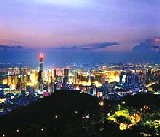 Located in eastern part of Guangzhou, Tianhe District is the geographical centre
of the city. Tianhe covers an area of about 139 square kilometers, with a
population of 1.2 million. Starting from Tianhe, through convenient and fast
road and rail transportation, you can easily reach the new Guangzhou Baiyun
International Airport, Guangzhou Huangpu Port, Nansha Port, and every corner
of the Pearl River Delta - the manufacturing centre in South China. Located in eastern part of Guangzhou, Tianhe District is the geographical centre
of the city. Tianhe covers an area of about 139 square kilometers, with a
population of 1.2 million. Starting from Tianhe, through convenient and fast
road and rail transportation, you can easily reach the new Guangzhou Baiyun
International Airport, Guangzhou Huangpu Port, Nansha Port, and every corner
of the Pearl River Delta - the manufacturing centre in South China.
Tianhe District, incorporating the functions of commerce, emerging industries,
information technology, culture and education, is the central district of Guangzhou.
The prosperous economy and commerce within the Tianhe District have attracted
many large shopping malls and class-A office buildings, leading the district
into being one of the most competitive and influential areas in Guangzhou.
Tianhe District boasts of rich resources of talents, education and R&D
capability. There are over 60 institutions of higher learning and R&D
in the district. Tianhe Software Park is listed among the ten most important
software manufacturing bases in China. Being the industrial base of internet
gaming and flash in Guangzhou, Gaotang New Zone within the Park has become
an important support to the Tianhe District's aim of developing their high
tech industry.
Baiyun District
Situated in the west and north of Guangzhou City and covering a land of nearly
900 square kilometers, Baiyun District has a population of more than 1.7 million
with 4 towns and 15 administrative streets under its jurisdiction. Baiyun
District is in possession of 6 of the 10 land exits of Guangzhou. Its road
density reaches the standard of world medium developed countries. Baiyun acts
as a transportation hub of Guangzhou and guards the passes of Guangzhou in
the directions of northeast, north, northwest and west. Baiyun connects well-developed
Pearl River Delta in the south and inner land which is full of resources in
the north. The new and old Baiyun international airports and the largest railway
marshalling yard in south China, and Beijing-Guangzhou, guangzhou-Shenzhen,
guangzhou-Foshan, Beijing-Zhuhai, guangzhou-Huizhou, 105, 106, 107 highways
or national roads passes through this district.
Huangpu District
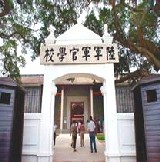 Huangpu
District, located in the north of Pearl River Delta and the east of Guangzhou,
is in the intersection of Pearl River and the estuary of Dongjiang River.
Huangpu is 148 kilometers away from Shenzhen, and 80 nautical miles apart from
Hong Kong. Covering 94.23 square kilometers, Huangpu has a total population
of 400,000. Huangpu
District, located in the north of Pearl River Delta and the east of Guangzhou,
is in the intersection of Pearl River and the estuary of Dongjiang River.
Huangpu is 148 kilometers away from Shenzhen, and 80 nautical miles apart from
Hong Kong. Covering 94.23 square kilometers, Huangpu has a total population
of 400,000.
Enjoying abundant tourism resources like "Huangpu Military Academy" and "South
China Sea God Temple", Huangpu is a modern industrial base in the east
of Guangzhou. Huangpu has complete industrial varieties and covers many industries
including automobile, petroleum, chemical industry, iron and steel, electronics,
machinery and food.
Huangpu District provides domestic and foreign investors with great potential
for business development, thanks to the advantages involving long industrial
chain, great volume of logistics, a diversity of traffic by railway, highway
and waterway. Huangpu Port has the largest port in South China whose international
shipping lines can reach more than 300 ports in over 100 countries and areas.
A convenient transportation network has been built in Huangpu, like guangzhou-Shenzhen
Railway and Expressway, 107 national highway, Guangyuan East Express Trunk.
They run through the whole district and connect Guangzhou, Shenzhen and Kowloon.
No.5, 7 and 9 Metro Lines are planned to be constructed to run through
Huangpu. It takes no more than 30 minutes from Huangpu District to new Baiyun
Airport.
Huadu District
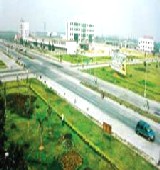 Huadu
District was an independent county a decade ago, established as a county in
the Qing Dynasty (1644-1911). Huadu was recognized as a city in 1993, and
in 2000 became an attached suburban district of Guangzhou with a population
of over 713,400. Huadu District is located in the north part of the Pearl
River Delta and abuts to Hong Kong and Macao. Huadu (Flower Capital in Chinese)
lies northwest of Guangzhou, fenced in by mountains to the east, north and
west. The Tropic of Cancer runs through the district, bringing a warm and
humid climate to this area. Huadu is often called the barrier of the capital
city of Guangzhou and the throat of North Guangdong and South Guangdong. Huadu
District was an independent county a decade ago, established as a county in
the Qing Dynasty (1644-1911). Huadu was recognized as a city in 1993, and
in 2000 became an attached suburban district of Guangzhou with a population
of over 713,400. Huadu District is located in the north part of the Pearl
River Delta and abuts to Hong Kong and Macao. Huadu (Flower Capital in Chinese)
lies northwest of Guangzhou, fenced in by mountains to the east, north and
west. The Tropic of Cancer runs through the district, bringing a warm and
humid climate to this area. Huadu is often called the barrier of the capital
city of Guangzhou and the throat of North Guangdong and South Guangdong.
Huadu, with its beautiful scenery and international facilities for entertainment,
recreation and living, is like a large-scale modern city offering excellent
investment prospects. With a rich rainfall, Huadu is abundant in a variety
of crops, vegetables, tea, litchis, bananas, longans, peanuts and sugarcane.
The new Baiyun Airport is located in Huadu, which is connected with the other
districts and cities nearby through the subway and Jichang Expressway. Guangzhou
Northern Train Station, as a switchyard of cargo trains, is also located in
Huadu District.
Panyu District
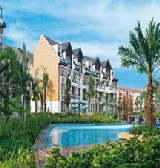 Panyu
is a new district under the administration of Guangzhou, located in the southeast
of Guangzhou.Panyu is the center of the Pearl River delta region. Covering
an area of 1313.8 square kilometers, Panyu is 38 sea miles away from Hong
Kong and 42 sea miles from Macao. With a crisscross network of highways
and water channels, Lianhuashan Harbor provides a direct shipping access
to Hong Kong and Kowloon. Panyu
is a new district under the administration of Guangzhou, located in the southeast
of Guangzhou.Panyu is the center of the Pearl River delta region. Covering
an area of 1313.8 square kilometers, Panyu is 38 sea miles away from Hong
Kong and 42 sea miles from Macao. With a crisscross network of highways
and water channels, Lianhuashan Harbor provides a direct shipping access
to Hong Kong and Kowloon.
Benefited from the opening, reform policy and its geography, the economy
of Panyu has grown rapidly and drastically. So far, there are many key construction
projects in the district as follows: The University Town, which has put into
operation, The New Railway Station, two metro line projects, a couple of
expressways and Nansha Branch of Guangzhou Port etc.
Nansha District
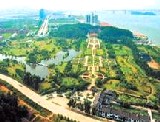 As
the geographic center of the Pearl River Delta, Nansha's future attracts
nearby cities, especially Hong Kong, Macao, Shenzhen, Zhongshan, Dongguan
and Zhuhai. It takes about an hour or so to go from Nansha District to any
of the cities mentioned above. As
the geographic center of the Pearl River Delta, Nansha's future attracts
nearby cities, especially Hong Kong, Macao, Shenzhen, Zhongshan, Dongguan
and Zhuhai. It takes about an hour or so to go from Nansha District to any
of the cities mentioned above.
Guangdong Government is hoping to turn Nansha into another Shenzhen over
the next few years. When construction is all completed, the place will become
the largest water and land transportation hub in the Pearl River Delta, a
major commercial city and a holiday resort catering to people from Hong Kong
and Macao.
Luogang District
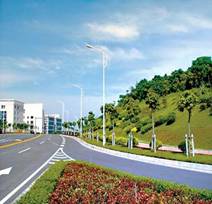 Located
in the eastern part, the new Luogang District covers an area of 395 square
kilometers with a population of 320,000. The Luogang Central Area in the center
of Luogang District is planned as an administrative center integrating various
functions of administrative office, culture, education, sports, residence and
retail support facilities etc. Located
in the eastern part, the new Luogang District covers an area of 395 square
kilometers with a population of 320,000. The Luogang Central Area in the center
of Luogang District is planned as an administrative center integrating various
functions of administrative office, culture, education, sports, residence and
retail support facilities etc.
|

 As
one of the oldest urban areas in the city Yuexiu District is the birthplace
of Guangzhou, which enjoys a long history of more than 2,000 years. The district
is the political centre of Guangzhou as the provincial and municipal governments
are both situated inside. Guangzhou is prosperous in commerce. Yuexiu is
just the city' s traditional shopping centre. The well-known showcases include
Beijing Pedestrian Street, Nonglinxia Road, Yide-road Dried Seafood Market
and Toy Street, Liuhua Clothing Markets, Zhuangyuan-Fang lane of Stationery
and fun items, Yanjiang (Riverside) Bar Street, Gaodi Clothing Business Street
, Tiancheng-road Market of printing, Taikang-road and Danan-road Markets of
home decoration, Jiefang-road Market of Electronics, Huifu-road Food Street
etc. All these have been attracting sea of shoppers, tourists and investors.
As
one of the oldest urban areas in the city Yuexiu District is the birthplace
of Guangzhou, which enjoys a long history of more than 2,000 years. The district
is the political centre of Guangzhou as the provincial and municipal governments
are both situated inside. Guangzhou is prosperous in commerce. Yuexiu is
just the city' s traditional shopping centre. The well-known showcases include
Beijing Pedestrian Street, Nonglinxia Road, Yide-road Dried Seafood Market
and Toy Street, Liuhua Clothing Markets, Zhuangyuan-Fang lane of Stationery
and fun items, Yanjiang (Riverside) Bar Street, Gaodi Clothing Business Street
, Tiancheng-road Market of printing, Taikang-road and Danan-road Markets of
home decoration, Jiefang-road Market of Electronics, Huifu-road Food Street
etc. All these have been attracting sea of shoppers, tourists and investors. Liwan
District is one of the old center districts of Guangzhou. The new Liwan District
has an area of 64.2 square kilometers after putting the administrative area
of the former Fangcun District under administration of Liwan District. With
over two thousand years of history, Liwan has always been a fascinating place
with beautiful sceneries and historic relics and one of the most prosperous
commercial centers in Guangzhou.
Liwan
District is one of the old center districts of Guangzhou. The new Liwan District
has an area of 64.2 square kilometers after putting the administrative area
of the former Fangcun District under administration of Liwan District. With
over two thousand years of history, Liwan has always been a fascinating place
with beautiful sceneries and historic relics and one of the most prosperous
commercial centers in Guangzhou.  Along with Liwan, Yuexiu and Dongshan Districts, the Haizhu District was
the largest in area and the least dense of the four old districts in Guangzhou
before the city expanded its size. Today, it is no longer the largest district
in area nor it is the southern most district, however, it has some of the
most pricey real estate in city. The eastern end of Guangzhou's Metro Line
2 reaches Haizhu District. Metro Lines 3 and 5, currently under construction,
will also have stations in the district. Another metro line, the Guangfo
Line, is currently under construction and will connect Guangzhou and Foshan,
a city just west of Guangzhou. If built, it will be the first and only metro
line connecting two cities in China.
Along with Liwan, Yuexiu and Dongshan Districts, the Haizhu District was
the largest in area and the least dense of the four old districts in Guangzhou
before the city expanded its size. Today, it is no longer the largest district
in area nor it is the southern most district, however, it has some of the
most pricey real estate in city. The eastern end of Guangzhou's Metro Line
2 reaches Haizhu District. Metro Lines 3 and 5, currently under construction,
will also have stations in the district. Another metro line, the Guangfo
Line, is currently under construction and will connect Guangzhou and Foshan,
a city just west of Guangzhou. If built, it will be the first and only metro
line connecting two cities in China. Located in eastern part of Guangzhou, Tianhe District is the geographical centre
of the city. Tianhe covers an area of about 139 square kilometers, with a
population of 1.2 million. Starting from Tianhe, through convenient and fast
road and rail transportation, you can easily reach the new Guangzhou Baiyun
International Airport, Guangzhou Huangpu Port, Nansha Port, and every corner
of the Pearl River Delta - the manufacturing centre in South China.
Located in eastern part of Guangzhou, Tianhe District is the geographical centre
of the city. Tianhe covers an area of about 139 square kilometers, with a
population of 1.2 million. Starting from Tianhe, through convenient and fast
road and rail transportation, you can easily reach the new Guangzhou Baiyun
International Airport, Guangzhou Huangpu Port, Nansha Port, and every corner
of the Pearl River Delta - the manufacturing centre in South China.  Huangpu
District, located in the north of Pearl River Delta and the east of Guangzhou,
is in the intersection of Pearl River and the estuary of Dongjiang River.
Huangpu is 148 kilometers away from Shenzhen, and 80 nautical miles apart from
Hong Kong. Covering 94.23 square kilometers, Huangpu has a total population
of 400,000.
Huangpu
District, located in the north of Pearl River Delta and the east of Guangzhou,
is in the intersection of Pearl River and the estuary of Dongjiang River.
Huangpu is 148 kilometers away from Shenzhen, and 80 nautical miles apart from
Hong Kong. Covering 94.23 square kilometers, Huangpu has a total population
of 400,000.  Huadu
District was an independent county a decade ago, established as a county in
the Qing Dynasty (1644-1911). Huadu was recognized as a city in 1993, and
in 2000 became an attached suburban district of Guangzhou with a population
of over 713,400. Huadu District is located in the north part of the Pearl
River Delta and abuts to Hong Kong and Macao. Huadu (Flower Capital in Chinese)
lies northwest of Guangzhou, fenced in by mountains to the east, north and
west. The Tropic of Cancer runs through the district, bringing a warm and
humid climate to this area. Huadu is often called the barrier of the capital
city of Guangzhou and the throat of North Guangdong and South Guangdong.
Huadu
District was an independent county a decade ago, established as a county in
the Qing Dynasty (1644-1911). Huadu was recognized as a city in 1993, and
in 2000 became an attached suburban district of Guangzhou with a population
of over 713,400. Huadu District is located in the north part of the Pearl
River Delta and abuts to Hong Kong and Macao. Huadu (Flower Capital in Chinese)
lies northwest of Guangzhou, fenced in by mountains to the east, north and
west. The Tropic of Cancer runs through the district, bringing a warm and
humid climate to this area. Huadu is often called the barrier of the capital
city of Guangzhou and the throat of North Guangdong and South Guangdong.  Panyu
is a new district under the administration of Guangzhou, located in the southeast
of Guangzhou.Panyu is the center of the Pearl River delta region. Covering
an area of 1313.8 square kilometers, Panyu is 38 sea miles away from Hong
Kong and 42 sea miles from Macao. With a crisscross network of highways
and water channels, Lianhuashan Harbor provides a direct shipping access
to Hong Kong and Kowloon.
Panyu
is a new district under the administration of Guangzhou, located in the southeast
of Guangzhou.Panyu is the center of the Pearl River delta region. Covering
an area of 1313.8 square kilometers, Panyu is 38 sea miles away from Hong
Kong and 42 sea miles from Macao. With a crisscross network of highways
and water channels, Lianhuashan Harbor provides a direct shipping access
to Hong Kong and Kowloon. As
the geographic center of the Pearl River Delta, Nansha's future attracts
nearby cities, especially Hong Kong, Macao, Shenzhen, Zhongshan, Dongguan
and Zhuhai. It takes about an hour or so to go from Nansha District to any
of the cities mentioned above.
As
the geographic center of the Pearl River Delta, Nansha's future attracts
nearby cities, especially Hong Kong, Macao, Shenzhen, Zhongshan, Dongguan
and Zhuhai. It takes about an hour or so to go from Nansha District to any
of the cities mentioned above.  Located
in the eastern part, the new Luogang District covers an area of 395 square
kilometers with a population of 320,000. The Luogang Central Area in the center
of Luogang District is planned as an administrative center integrating various
functions of administrative office, culture, education, sports, residence and
retail support facilities etc.
Located
in the eastern part, the new Luogang District covers an area of 395 square
kilometers with a population of 320,000. The Luogang Central Area in the center
of Luogang District is planned as an administrative center integrating various
functions of administrative office, culture, education, sports, residence and
retail support facilities etc.